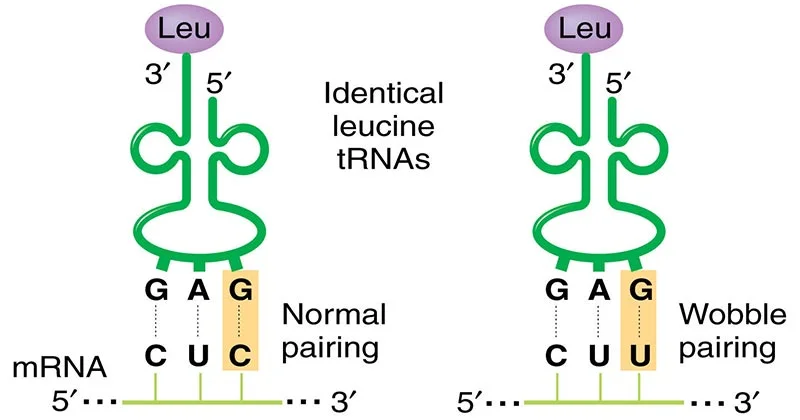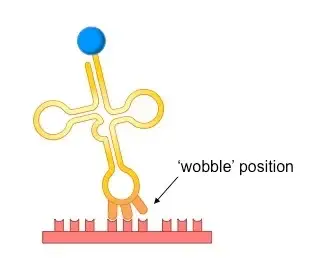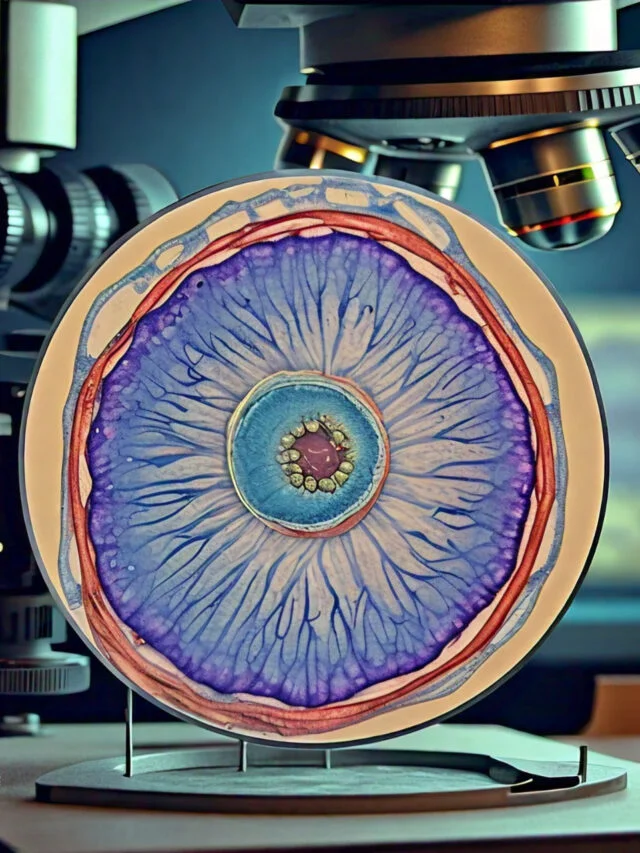Contents
What is The Wobble Hypothesis?
The Wobble Hypothesis, proposed by Francis Crick in 1966, provides an explanation for the degeneracy of the genetic code. Degeneracy refers to the fact that multiple codons can code for the same amino acid. According to the Wobble Hypothesis, the precise pairing between the bases of the codon and the anticodon of tRNA occurs only for the first two bases of the codon. However, the pairing between the third base of the codon and the anticodon can exhibit some flexibility or “wobble.”
In other words, the third base of the codon and the anticodon can sway or move unsteadily, allowing for non-standard base pairing. This phenomenon enables a single tRNA molecule to recognize and bind to multiple codons, despite differences in their third base. As a result, although there are 61 codons that code for amino acids, the number of tRNA molecules is significantly lower (around 40) due to wobbling.
Wobble base pairs play a crucial role in RNA secondary structure and are critical for accurate translation of the genetic code. The four main wobble base pairs are guanine-uracil (G-U), hypoxanthine-uracil (I-U), hypoxanthine-adenine (I-A), and hypoxanthine-cytosine (I-C). These wobble base pairs exhibit thermodynamic stability comparable to that of Watson-Crick base pairs.
In the genetic code, there are 64 possible codons, out of which three are stop codons that terminate translation. If canonical Watson-Crick base pairing were required for each codon, it would necessitate 61 different types of tRNA molecules. However, most organisms have fewer than 45 types of tRNA. The Wobble Hypothesis explains how some tRNA molecules can recognize multiple synonymous codons, which encode the same amino acid.
Crick proposed that the 5′ base on the anticodon, which binds to the 3′ base on the mRNA codon, is more flexible spatially compared to the other two bases. This flexibility allows for non-standard base pairing and small conformational adjustments, resulting in the overall pairing geometry of tRNA anticodons.
Overall, the Wobble Hypothesis provides a mechanism to account for the degeneracy of the genetic code and the ability of a limited number of tRNA molecules to recognize and bind to multiple codons. The wobbling of the third base allows for greater flexibility in genetic coding while maintaining the accuracy of translation.
Definition of Wobble Hypothesis
The Wobble Hypothesis proposes that the third base of a codon and the anticodon of tRNA can exhibit flexibility or “wobble” in their base pairing, allowing a single tRNA molecule to recognize and bind to multiple codons, contributing to the degeneracy of the genetic code.
The Wobble Hypothesis
The wobble hypothesis, proposed by Francis Crick in 1966, provides an explanation for the flexibility observed in the genetic code’s translation process. This hypothesis focuses on the base-pairing rules between the codon in messenger RNA (mRNA) and the anticodon in transfer RNA (tRNA). Specifically, it addresses the variability allowed at the third position of the codon-anticodon interaction.
Key Points of the Wobble Hypothesis
- Base Pairing at the Third Codon Position:
- The base at the 5′ end of the anticodon (tRNA) is not as spatially confined as the other two bases.
- This allows it to form hydrogen bonds with multiple bases at the 3′ end of a codon (mRNA).
- Canonical and Non-Canonical Pairing:
- The first two bases of the codon adhere to normal (canonical) hydrogen bond pairing with the second and third bases of the anticodon.
- The third position, however, follows less stringent rules, allowing non-canonical pairing.
- Flexibility in Base Pairing:
- This hypothesis introduces a more flexible set of base-pairing rules at the third position of the codon.
- The relaxed base-pairing requirement, referred to as “wobble,” permits a single form of tRNA to pair with multiple triplets in mRNA.
- Base Recognition Rules:
- The first base of the anticodon (tRNA) has specific pairing capabilities:
- U (uracil) can recognize A (adenine) or G (guanine).
- G (guanine) can recognize U (uracil) or C (cytosine).
- I (inosine) can recognize U (uracil), C (cytosine), or A (adenine).
- The first base of the anticodon (tRNA) has specific pairing capabilities:
Implications of the Wobble Hypothesis
- Efficiency in Translation:
- The wobble hypothesis allows for fewer tRNA molecules to be required for the translation process, enhancing efficiency.
- It explains why there are fewer tRNA species than there are codons, as one tRNA can recognize multiple codons.
- Genetic Code Redundancy:
- The hypothesis supports the redundancy of the genetic code, where multiple codons can code for a single amino acid.
- This redundancy, facilitated by wobble base pairing, provides a buffer against mutations, ensuring accurate protein synthesis even with some variations in the genetic code.
- Critical Role of First Two Bases:
- Crick’s hypothesis emphasizes that the first two ribonucleotides of the triplet codon are crucial for attracting the correct tRNA.
- The third position, being more flexible, accommodates variations without compromising the fidelity of translation.

Wobble base pairs

In molecular biology, a wobble base pair refers to a non-standard pairing between nucleotides in RNA that does not adhere to the traditional Watson-Crick base-pairing rules. The concept of wobble base pairs plays a crucial role in the flexibility and efficiency of the genetic code during the process of translation.
Understanding Wobble Base Pairs
- Traditional vs. Wobble Base Pairs:
- Traditional Watson-Crick base pairs include adenine-thymine (A-T) and guanine-cytosine (G-C) in DNA, and adenine-uracil (A-U) in RNA.
- Wobble base pairs, however, deviate from these conventional rules and can form between bases that are not typically paired.
- Primary Wobble Base Pairs:
- There are four main types of wobble base pairs:
- Guanine-Uracil (G-U)
- Hypoxanthine-Uracil (I-U)
- Hypoxanthine-Adenine (I-A)
- Hypoxanthine-Cytosine (I-C)
- Hypoxanthine is the nucleobase of inosine, which is represented by “I” in nucleic acid nomenclature.
- There are four main types of wobble base pairs:
- Role of Inosine:
- Inosine is particularly important in wobble base pairing due to its ability to pair with multiple bases.
- When inosine is the first nucleotide in the anticodon of tRNA, it can pair with uracil (U), adenine (A), or cytosine (C) in the codon.
Significance of Wobble Base Pairs
- Flexibility in Translation:
- The presence of wobble base pairs allows for greater flexibility in the genetic code. This means a single tRNA molecule can recognize and pair with multiple codons, thus simplifying the translation process.
- Genetic Code Redundancy:
- Wobble base pairs contribute to the redundancy of the genetic code, where multiple codons can code for the same amino acid. This redundancy helps protect against mutations, ensuring that proteins are synthesized accurately.
- Efficiency in Protein Synthesis:
- The ability of a tRNA molecule to recognize multiple codons through wobble base pairing reduces the number of tRNA species needed, thereby enhancing the efficiency of protein synthesis.
Key Points to Remember
- Wobble base pairs are non-standard pairings in RNA that deviate from Watson-Crick rules.
- The primary wobble base pairs are G-U, I-U, I-A, and I-C.
- Inosine, represented as “I,” plays a crucial role in wobble base pairing due to its versatility in pairing with U, A, or C.
- Wobble base pairing enhances the flexibility, efficiency, and redundancy of the genetic code, contributing to the robustness of protein synthesis.

Short Exaplanation of The Wobble Hypothesis
Let’s dive into the Wobble Hypothesis step by step.
The Wobble Hypothesis is a concept that explains how the genetic code, stored in the form of nucleotides, is translated into proteins by the ribosome. To understand this hypothesis, we need to know a little bit about codons and anticodons.
Codons are sequences of three nucleotides in mRNA, and each codon corresponds to a specific amino acid or a stop signal. On the other hand, anticodons are sequences of three nucleotides in tRNA that bind to the codon during protein synthesis.
According to the Wobble Hypothesis, the base at the 5′ end of the anticodon is not as restricted in its pairing as the other two bases. This means that the first two bases of the codon and anticodon form normal hydrogen bond pairs, following the usual base-pairing rules (A with U, G with C). However, at the third position of the codon, the rules are more relaxed, and non-canonical pairing can occur.
In other words, the third base of the codon and the first base of the anticodon can form “wobble” pairs that do not strictly follow the A-U and G-C base-pairing rules. This flexibility allows the anticodon of a single tRNA molecule to recognize and bind to more than one codon with different nucleotide sequences at the third position.
To give you some examples of the wobble pairing rules:
- If the first base of the anticodon is U, it can recognize codons with A or G as the third base.
- If the first base of the anticodon is G, it can recognize codons with U or C as the third base.
- If the first base of the anticodon is I (Inosine), it can recognize codons with U, C, or A as the third base.
By allowing this “wobble” or relaxed base-pairing, the cell can minimize the number of tRNA molecules needed for protein synthesis. It provides flexibility and efficiency in translating the genetic code.
So, in summary, the Wobble Hypothesis proposes that the third base of the codon and the first base of the anticodon can form non-standard base pairs, leading to a more flexible set of base-pairing rules at the third position of the codon. This flexibility allows a single tRNA molecule to recognize and bind to multiple codons with different nucleotide sequences at the third position, optimizing protein synthesis.
Importance of the Wobble Hypothesis
- Efficient Translation:
- Our bodies possess a limited number of tRNA molecules. The wobble hypothesis explains how fewer tRNA molecules can recognize multiple codons coding for the same amino acid.
- This reduces the number of tRNA species required for protein synthesis, streamlining the translation process and making it more efficient.
- Error Reduction:
- The hypothesis allows for flexibility in base pairing at the third position of the codon-anticodon interaction, which helps reduce the impact of errors or mutations in the genetic code.
- For example, if a codon for leucine (Leu), such as CUU, is misread as CUC, CUA, or CUG, it will still be translated as leucine, minimizing errors in protein synthesis.
- Thermodynamic Stability:
- The thermodynamic stability of a wobble base pair is comparable to that of a Watson-Crick base pair, ensuring stable and accurate translation of the genetic code.
- Evolutionary Conservation:
- The wobble hypothesis is evolutionarily conserved across species, indicating its fundamental importance in translation.
- This conservation suggests that wobble base pairing provides an evolutionary advantage by allowing for greater adaptability and efficiency in protein synthesis.
- Understanding Genetic Code Variability:
- The hypothesis helps explain the variability in the genetic code, where multiple codons can code for the same amino acid.
- This variability provides flexibility and redundancy in the genetic code, allowing for robustness and adaptability in the face of genetic mutations and environmental changes.
- RNA Secondary Structure:
- Wobble base pairs are fundamental in forming RNA secondary structures, which are critical for proper translation of the genetic code.
- Faster Dissociation and Protein Synthesis:
- Wobbling allows for faster dissociation of tRNA from mRNA, speeding up the protein synthesis process.
- Biotechnological Applications:
- Understanding the wobble hypothesis is crucial in biotechnology and genetic engineering applications.
- It informs the design of synthetic genes and optimization of codon usage to enhance protein expression in heterologous expression systems.
Case Study: Escherichia coli
- Practical Evidence:
- Wobble base pairs have been shown to facilitate many biological functions, most clearly demonstrated in the bacterium Escherichia coli.
- In E. coli, the flexibility provided by wobble base pairing enhances the efficiency and accuracy of protein synthesis, highlighting the practical significance of this hypothesis.
Examples of Wobble Hypothesis
Example 1: Codon Recognition by tRNA
- Guanine-Uracil (G-U) Pairing:
- In the standard Watson-Crick base pairing, guanine (G) pairs with cytosine (C), and uracil (U) pairs with adenine (A).
- However, due to the wobble hypothesis, G in the anticodon can also pair with U in the codon.
- Example: The tRNA with anticodon 3′-CCG-5′ can pair with codons 5′-GGC-3′ and 5′-GGU-3′, both of which code for the amino acid glycine (Gly).
- Inosine Pairing:
- Inosine (I) is a modified nucleotide that can be present in the tRNA anticodon and can pair with A, U, or C in the codon.
- Example: The tRNA with anticodon 3′-IAU-5′ can recognize the codons 5′-AUA-3′, 5′-AUU-3′, and 5′-AUC-3′, all of which code for isoleucine (Ile).
Example 2: Redundancy in the Genetic Code
- The genetic code has redundancy, meaning that multiple codons can code for the same amino acid. The wobble hypothesis helps explain this redundancy by allowing a single tRNA to recognize different codons that code for the same amino acid.
- Example: The amino acid leucine (Leu) is coded by six different codons (CUU, CUC, CUA, CUG, UUA, UUG). A tRNA with the anticodon 3′-GAI-5′ can recognize codons 5′-CUU-3′, 5′-CUC-3′, and 5′-CUA-3′, while another tRNA with anticodon 3′-CAA-5′ can recognize codons 5′-UUG-3′ and 5′-UUA-3′.
Example 3: Practical Implications in Escherichia coli
- In the bacterium Escherichia coli, wobble base pairs facilitate efficient and accurate protein synthesis.
- Example: E. coli uses fewer tRNA species to decode the 61 sense codons of the genetic code. This is achieved by having tRNAs that can recognize multiple codons through wobble base pairing. For instance, E. coli tRNA^Arg with the anticodon 3′-ICG-5′ can pair with the codons 5′-CGA-3′, 5′-CGC-3′, and 5′-CGU-3′, all coding for the amino acid arginine (Arg).
Example 4: Minimizing Mutational Impact
- The wobble hypothesis helps minimize the impact of mutations in the genetic code by allowing flexibility in codon recognition.
- Example: If a codon for serine (Ser), such as AGU, undergoes a mutation at the third position to become AGC, it will still be recognized by the same tRNA with the anticodon 3′-UCA-5′, and serine will be incorporated into the protein, maintaining the correct amino acid sequence.
Example 5: Biotechnology and Genetic Engineering
- The understanding of the wobble hypothesis is applied in designing synthetic genes and optimizing codon usage for protein expression in different organisms.
- Example: When expressing a human protein in a bacterial system, scientists can optimize the codon usage to match the preferred codons of the host organism. By taking advantage of wobble base pairing, they can ensure efficient and high-level expression of the desired protein.
Quiz on Wobble Hypothesis
What does the Wobble Hypothesis explain?
a) The structure of DNA
b) The replication of DNA
c) The flexibility in the pairing of the third base of the codon
d) The synthesis of proteins
Who proposed the Wobble Hypothesis?
a) Rosalind Franklin
b) James Watson
c) Francis Crick
d) Maurice Wilkins
According to the Wobble Hypothesis, which position of the codon shows flexibility in base pairing?
a) First
b) Second
c) Third
d) Fourth
Which base can pair with multiple bases according to the Wobble Hypothesis?
a) Adenine
b) Cytosine
c) Guanine
d) Thymine
The Wobble Hypothesis helps to explain why:
a) There are more codons than amino acids
b) There are more amino acids than codons
c) Codons are always of fixed length
d) DNA is double-stranded
Which of the following is NOT a valid wobble pairing?
a) G-U
b) A-U
c) I-A
d) C-G
The Wobble Hypothesis reduces the need for:
a) Multiple DNA strands
b) Multiple types of amino acids
c) Multiple types of tRNAs
d) Multiple types of ribosomes
Inosine (I) can pair with which of the following bases?
a) Adenine
b) Cytosine
c) Both Adenine and Cytosine
d) Neither Adenine nor Cytosine
The Wobble Hypothesis is primarily associated with:
a) DNA replication
b) Transcription
c) Translation
d) DNA repair
The flexibility in base pairing, as proposed by the Wobble Hypothesis, occurs between:
a) mRNA codon and DNA template
b) mRNA codon and tRNA anticodon
c) tRNA anticodon and DNA template
d) tRNA anticodon and ribosomal RNA
FAQ
What is the wobble hypothesis?
The wobble hypothesis proposes that the base at the 5′ end of the anticodon in tRNA is not as strictly paired with the corresponding base in the mRNA codon, allowing for non-standard or wobble base pairings.
Why is it called the “wobble” hypothesis?
It is named the “wobble” hypothesis because the base at the wobble position is not spatially confined like the other two bases in the anticodon, allowing it to wobble or move unsteadily and form non-standard base pairs.
How does the wobble hypothesis explain degeneracy in the genetic code?
The wobble hypothesis suggests that the relaxed base-pairing rules at the third position of the codon allow a single tRNA molecule to recognize more than one codon. This accounts for the degeneracy or redundancy of the genetic code.
What are the main wobble base pairs?
The main wobble base pairs are guanine-uracil (G-U), hypoxanthine-uracil (I-U), hypoxanthine-adenine (I-A), and hypoxanthine-cytosine (I-C).
Why is hypoxanthine used in wobble base pairs?
Hypoxanthine is used to represent wobble base pairs because it is the nucleobase of inosine, which displays the true qualities of wobble by allowing for pairing with multiple bases in the original codon.
How does the wobble hypothesis impact protein synthesis?
The wobble base pairing allows for faster dissociation of tRNA from mRNA during protein synthesis, facilitating the movement of ribosomes and enhancing the efficiency of translation.
What role do wobble base pairs play in RNA secondary structure?
Wobble base pairs are fundamental in RNA secondary structure. They contribute to the stability and folding of RNA molecules, influencing their overall structure and function.
Does the wobble hypothesis affect the accuracy of the genetic code?
Yes, the wobble hypothesis helps to minimize errors in the interpretation of the genetic code. It ensures that even if there is a mismatch at the wobble position, the correct amino acid can still be incorporated during protein synthesis.
How does the wobble hypothesis impact the number of tRNA molecules needed?
The wobble hypothesis allows a single tRNA molecule to recognize multiple codons due to non-standard pairings. This broad specificity reduces the number of unique tRNA molecules required for translation.
How has the wobble hypothesis contributed to our understanding of molecular biology?
The wobble hypothesis has provided insights into the efficiency and accuracy of protein synthesis, RNA structure, and the functioning of the genetic code. It has enhanced our understanding of how cells optimize resources and maintain fidelity in the complex process of translating genetic information into functional proteins.
References
- https://microbenotes.com/the-wobble-hypothesis/
- https://en.wikipedia.org/wiki/Wobble_base_pair
- https://teaching.ncl.ac.uk/bms/wiki/index.php/Wobble_Hypothesis
- https://link.springer.com/referenceworkentry/10.1007%2F978-3-642-11274-4_1692
- https://www.biologydiscussion.com/genetics/wobble-hypothesis-with-diagram-genetics/65163











